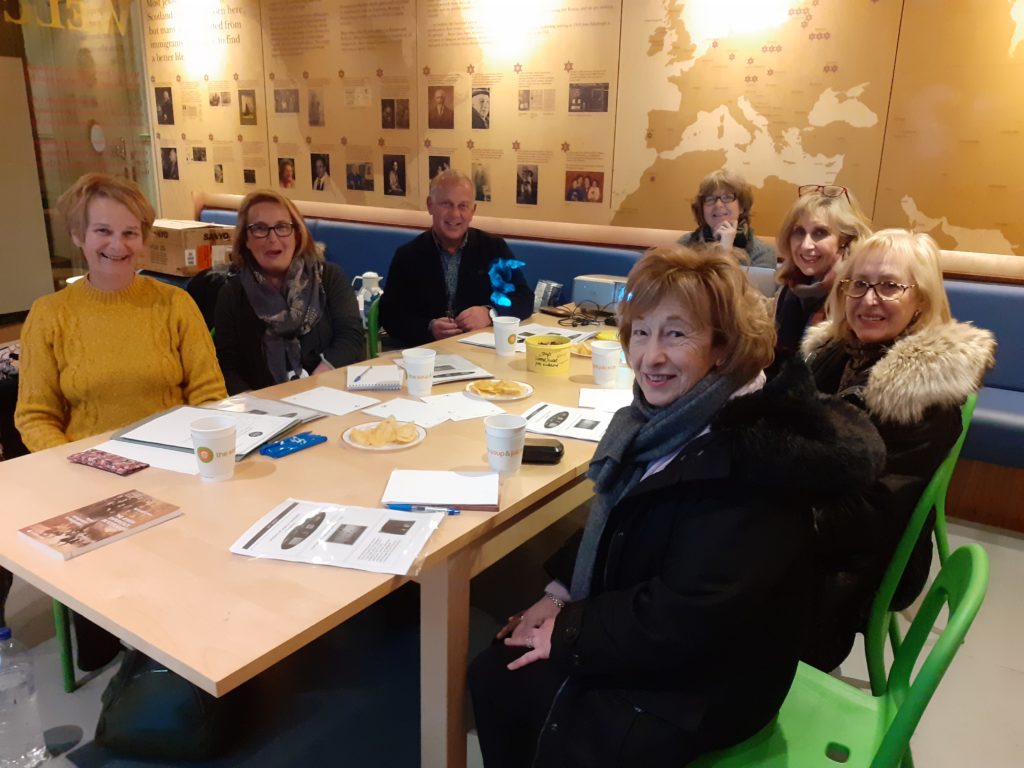The year began very positively with architectural repair and renovations works starting on site in January in the capable hands of Elmwood (Glasgow) Ltd under the guidance of Scott Abercrombie and the team at John Gilbert Architects.
Of course, everything stopped in March when the Covid-19 pandemic restrictions came into force. Covid-19 has since impacted every aspect of the project and inevitably led to delays.
Where we are now

Downstairs the architectural repair and refurbishment works are complete. Russell Eggleton of Abound and Design is now completing the installation of new furniture, equipment, resources and the interpretative displays in the foyer and in the Succah.

The Succcah is now a bright, welcoming and warm space opening onto the renovated courtyard and linked internally to the Study Centre. The Succah display offers visitors an overview of the Holocaust-era from 1930 through to the end of the Second World War, drawing on the diverse collections of the SJAC.

The Scottish Holocaust-era Study Centre has been created in the former kitchen. New research resources being installed include:
- The Jewish Echo weekly newspaper editions published in Glasgow from 1928 to 1950.
- A digital catalogue giving access to over 2,5000 items from the SJAC Holocaust-era colections.
- SJAC’s specialist Holocaust reference library.
- Three hands-on learning kits based on SJAC Holocaust-era collections.
Pupils visiting will be able to handle facsimiles and interrogate documents and photographs to find out about:
- Dorrith Sim (Oppenheim), who came from Kassel in Germany to Scotland aged 7. Dorrith escaped on a Kindertransport, reaching the UK in July 1939.
- Irene Marchand and her 10-year-old-son Ernst, who came to Scotland from Gelsenkirchen in the Ruhr in May 1939. Irene became a housekeeper for the Garnethill Refugee Hostel set up next to the synagogue in 1939.
- Hilda Goldwag, who came from Vienna in Austria to Scotlad in April 1939 after graduating from art school. Hilda escaped thatks to Max and Hedi Born’s daughter who arranged for her to enter the UK on a domestic visa.

An attractive new display in the synagogue foyer introduces Glasgow’s Jewish roots and Glasgow’s Jewish community dating back to 1821 whose successors built Garnethill Synagogue. There is a timeline from 1821 to2020. Panels highlight architectural features of this grade A listed building and feature some of the early congregants who contributed to the expanding 19th century city of Glasgow. Panels also introduce the Scottish Jewish Archives Centre and the new Scottish Holocaust-era Study Centre.
Downstairs there is now a bag store, new kosher kitchen, SJHC office and refurbished multi-purpose function room ready for the first new temporary exhibition to be installed. The title of the exhibition is: A new and very handsome synagogue – Garnethill Synagogue 1879 – Scotland’s oldest synagogue and the people who built it.
Next Steps
Volunteer-led public services.
Volunteer recruitment for the three new public services was halted by Covid-19 restrictions. We aim to resume recruitment and training, as soon as regulations permit, for
- Weekday Guiding Service – 17 volunteers were attending training sessions and learning about the history of the building, the displays, and how to manage groups.
- Weekend Events and Activities Service – A small group of volunteers, working with the SJAC staff team, have created the first temporary exhibition for the Function Room. This group, meeting via Zoom, is devising an events and activities programme, taking into account adjustments needed to respond to the Covid-19 restrictions for 2021 events.
- School Visit Service – We anticipate Covi-19 Restrictions will make it unlikely schools can visit in 2021. We want to look at how best to get information about the centre to schools. We are taking advice from our Holocaust education specialist Dr Paula Cowan and from Douglas Robert, Education Consultant (Scottish Council on Archives), to assist us with our planning for onsite visits and examine how best to communicate and support schools in this uncertain time.
- Publicity/Public Relations – We will aim to recruit new volunteers to assist with publicity in advance of the launch.
Scottish Jewish Heritage Centre Manager
We are re-advertising the post and aim to have an appointee in place as early in Spring 2021 as possible. First tasks include starting up a SJHC website and coordination for the public services and taking forward the day to day running of the project following the launch.
New Operational Management Body
We will be setting up a SCIO to run the SJHC. The SCIO will have 9 trustees (3 each from the project partners – SJAC and GSPT – and 3 independents, on of whom will be the chair.)
Revenue fundraising
A small group of SJAC volunteers, led by SJAC’s Honorary Treasurer, continues raising funds for the SJHC to provide a secure funding base for the first five years of operation after the NLHF operating grant expires. To date they have secured pledges totalling £210,000. This will cover the first two years of operation entirely and significantly contribute to the following three years.
All of this has been made possible by
Capital grant funds from: The National Lottery Heritage Fund; The Association of Jewish Refugees; The Wolfson Family Charitable Trust; The Consulate General of the Federal Republic of Germany, Edinburgh; The Architectural Heritage Fund – William Grant Foundation; The Community Security Trust.
Invaluable input from our grant giving bodies, our specialist advisors, a host of volunteers and people from a wide range of organisations who help in so many ways. Thank you!
A lot of hard work by the project staff, the Working Group members and the partner trustees of SJAC and GSPT.
We look forward to welcoming volunteers and visitors to the Centre in 2021. In the meantime, if you wish any further information or want to get involved or to donate to the revenue running costs please email: info@sjac.org.uk




